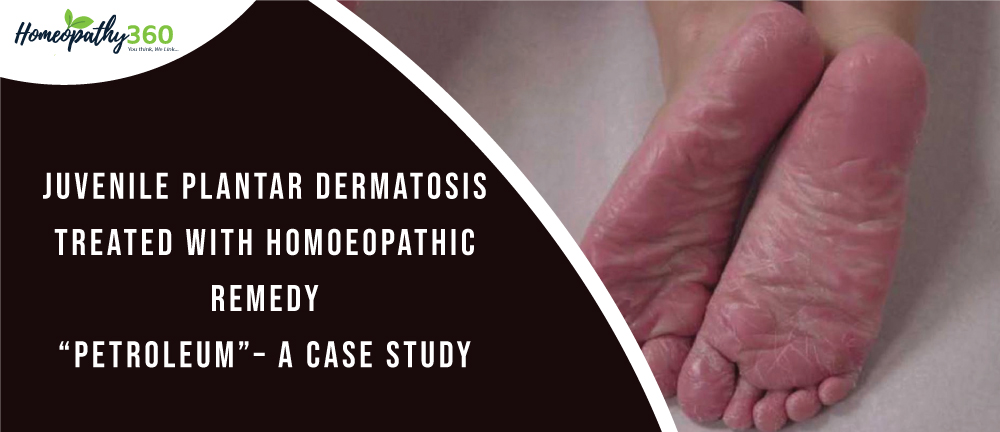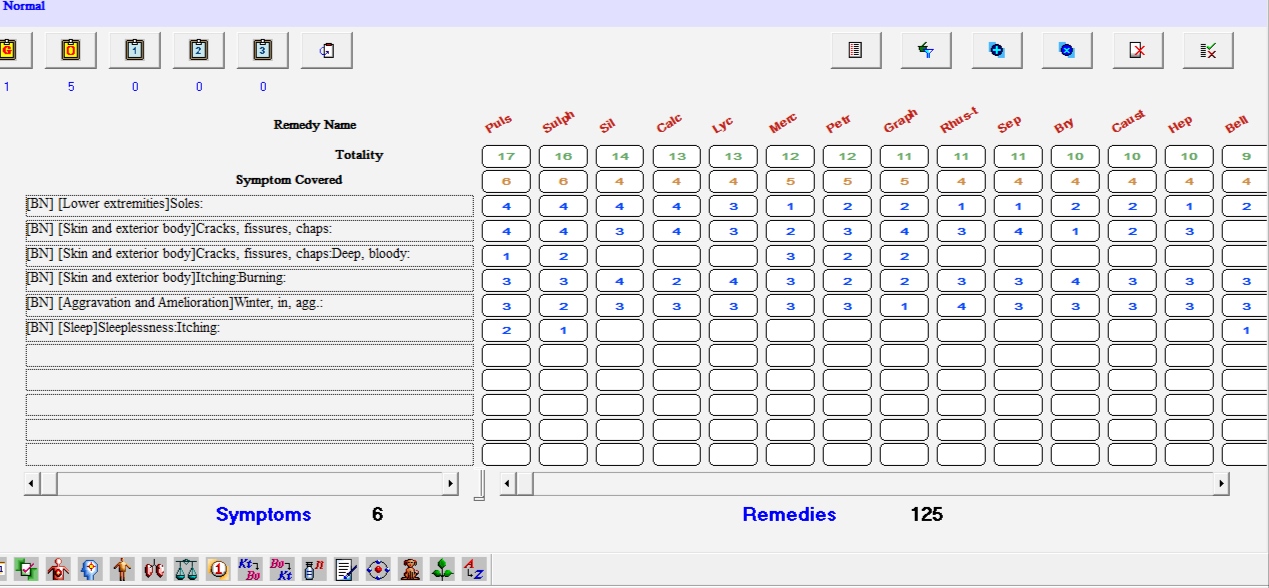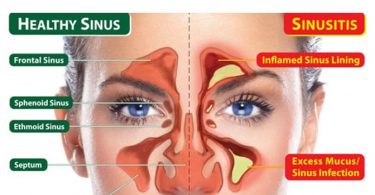
ABSTRACT: “Wet and dry foot syndrome”, also known as juvenile plantar dermatosis is a chronic condition of children and young adolescents (ages 3-14 years), characterised by symmetrical peeling and cracks of the feet which carries entire body weight.The rationale of this case study is to display the efficiency of homoeopathic treatment with the remedy, Petroleum, in a case of a 12 year old female presenting with complaints of cracks and fissures in the soles with painful burning, itching and mild bleeding. Significant noticeable improvement appeared in lesions and associated complaints as assessed with VAS scale, it shows that homoeopathy perhaps is an effective treatment for juvenile plantar dermatosis with careful selection of medicine as per totality of symptoms of patient.
Key words-juvenile plantar dermatosis, homoeopathy, Petroleum, VAS scale
Abbreviations:agg. – aggravation, amel. – amelioration, VAS (visual analogue scale), JPD (juvenile plantar dermatosis)
INTRODUCTION:
Juvenile plantar dermatosis is a condition characterised by dry, fissured dermatitis of the plantar surface of the forefoot. It occurs almost exclusively in children aged 3-14 years.[1]The primary underlying mechanism of JPD is a cycle of excessive moisture followed by rapid drying, which leads to cracking and fissuring the plantar surfaces of the foot.[2]It may be caused by : repetitive frictional movements, occlusive effect of covered footwear, excessive sweating, genetic sensitivity of skin, climatic changes.[3]The presenting features are redness and pain in plantar surface of the forefoot, which assumes glazed and cracked appearance. The condition more severe on the ball of the foot and toe pads, tending to spare the non-weight bearing instep. The toe clefts are normal, and this helps to distinguish the condition from tinea pedis. The symmetry of the lesions is a striking feature. It is usually clinically diagnosed. Most cases clear spontaneously in due course.[1]
The diagnosis of JPD is based primarily on physical examination of the feet. Also, many individuals will report a history of excessive sweating of foot and sometimes the palms as well.[2]
In severe cases with cracks and exudation, bed rest may be needed. A variety of topical preparations may help, including steroids, urea preparations, Lassar’s paste, or tar, but no single preparations helps in all cases.[1]The best method can be prevention which can be accomplished by obtaining breathable footwear which helps in preventing drying. Use of occlusive, soothing ointment to affected areas of foot immediately after shoe removal which keeps the plantar surfaces of the feet from drying out too rapidly.[2]
Homoeopathy is a treatment based on ‘like cures like’ principle. Homoeopaths usually employ highly diluted remedies in order to stimulate the self-healing properties of bodies. Thus, homoeopathy is a holistic approach used for many skin disorders. [4]
CASE:
A 12 year old female reported on 7th November 2021 with the complaints of:
| Location | Sensation | Modalities | Concomitants |
| Soles (near metatarsal joints) since 1 month | Burning pain itching Cracks Bleeding occasionally Difficulty in walking | <night <walking <winter >warm water application (keeping feet in warm water) |
Patient had a habit of walking around barefoot usually.
She had a history of cracks of the soles in winters since 2 years. Father had a similar history of plantar fissures and allergic respiratory complaints, especially in winters.
Her appetite was increased, she ate frequently (drinks tea in the morning, 2 chapattis in the morning, 2-3 chapattis at lunch + dal and rice, 3 chapattis and rice at dinner). She disliked eating cabbage as it causes diarrhoea after eating. Patient was usually thirstless (drinks hardly 2 glasses of water a day). She had generalised perspiration. Her urine and bowel movements were regular and normal. Patient’s thermal reaction was chilly. Her sleep was disturbed due to burning pain and itching.
According to mother, the girl became irritable since the development of complaints.
CLINICAL FINDINGS:
Patient was moderately built and nourished, tall, wheatish complexion. Skin was dry, in general.
No signs of pallor, cyanosis, anaemia, jaundice.
Weight – 30 kgs
Local examination of soles:
Inspection: Fissures and small cracks with mild bleeding. There was mild erythema around some of the fissures. Dry crusting was seen at the edges. Borders of the cracks were indistinct. No visible scaling. Colour: blackish discolouration slightly. Smell: no foul smell
Palpation: Skin was rough and thickened, tenderness present. Temperature: neither cold nor hot
DIAGNOSIS:
According to the clinical presentation and examination it was diagnosed as juvenile plantar dermatosis.[1][2]
| ANALYSIS | EVALUATION | PSORA | LT. PSORA |
| COMMON | Irritability | 1 | 1 |
| Bilateral fissures and cracks of soles | Bilateral fissures and cracks of soles | ||
| Burning pain with itching of soles and mild bleeding | Burning pain with itching of soles | 1 | 1 |
| Itching < winter, walking | mild bleeding | ||
| Dry, rough skin | Itching < winter | ||
| UNCOMMON | Itching < walking | 1 | 1 |
| Irritable | Itching <night | ||
| Itching < night | Itching > keeping feet in warm water | ||
| Itching > keeping feet in warm water | Dry, rough skin | 1 | 1 |
| 4 | 4 |
Thus, PSORA is the predominant miasm of the case after repertorisation, according to Dr R. P. Patel’s Miasmatic repertory[5]
SELECTION OF REPERTORY-
In this case, more of particular symptoms were available with location, sensation, modalities and a few generals, hence Boenninghausen`s repertory was chosen.
REPERTORISATION: Hompath Classic version 8[6]

REMEDIAL DIFFERENTIAL DIAGNOSIS: [7]
- Pulsatilla nigricans– changeability of symptoms, urticarial after rich food, worse from heat, warm room, better open air, cold applications.
- Sulphur– It is an anti-psoric remedy with skin affections with itching and burning. Dry scaly. Unhealthy people prone to skin affections< warmth in bed, washing, bathing. >dry warm weather.
- Silicea terra– delicate, pale, waxy skin, cracks at the end of the fingers, worse in morning, from cold, from washing, better warmth, summer, in wet humid weather
- Calcarea carbonicum–anti-psoric, unhealthy skin, small wounds do not heal easily, worse from cold in every form, washing, water, wet weather, Better by dry climate.
- Lycopodium clavatum– skin worse by warm applications, warmth. Violent itching, fissured eruptions. Skin becomes thick and indurated, viscid and offensive perspiration
- Mercurius solubilis-Syphilitic remedy. Almost constantly moist skin, persistent dry skin contraindicates mercurius. Excessive odorous viscid perspiration. Eruptions with itching worse from warmth of bed. All symptoms worse by night, wet damp weather, perspiring better in warm room, warm bed
- Petroleum-Psoric remedy. Skin is dry, constricted, very sensitive, rough and cracked. Burning and itching. Cracks bleed easily. Worse from dampness, winter. Better by warm air, dry weather (Phatak Materia Medica[8]-diarrhoea aggravated by cabbage, skin dirty, rough, thickened, like parchment, deep cracks).
- Graphites– rough, hard, persistent dryness of skin. Cracks with burning stinging pain. Worse warmth, night, Better in dark, wrapping up.
Final remedy selected-Petroleum
It was selected on the basis of: [9]
- Exposure to winter : deep blood rhagades
- Amelioration from warmth
- Severe itching, smarting pains, skin cracked and bleeding
- Irritability, child vehement, susceptible to electric changes, cracked, bleeding rhagades
- Rhagades , particularly when occurring in winter, crack and burn, and itch intolerably
- Deep cracks and fissures which bleed and suppurate.
- Diarrhoea from cabbage
PRESCRIPTION: as on 07-11-2021, (Fig.1), VAS score 10.
Petroleum 200/1 stat was given.
FOLLOW UP: Pain assessed using visual analogue survey scale [10]

| DATE | SYMPTOMS | REMEDY |
| 14-11-2021 | Erythema absent. Pain and itching slightly reduced. Skin dry. The edges of the cracks are smoothened. No change in disturbed sleep. Advised to gently cleanse and exfoliate the skin of the feet every day, drink more water. VAS Score- 9 (Fig.2) | Petroleum 200/1 dose |
| 21-11-2021 | Erythema absent. Pain and itching absent. Sleep is better. She is able to walk but has to limp slightly. Given same advice. VAS Score- 4 | Plx 1 week BD |
| 28-11-2021 | No cracks, itching absent, erythema absent, itching and pain absent, skin moisturised, able to walk to school. VAS Score-0 (Fig.3) | Plx 1 week BD |
| 5-12-2021 | Improvement stable in all domains. VAS Score-0 | Plx 1 week BD |

DISCUSSION:
Homoeopathy is a system of therapeutics which aims at a rapid, gentle and permanent restoration of health. In this case, Petroleum was selected on the basis of totality of symptoms and this was successful in the treatment of the condition as well as recovered the accessory complaints of the patient. Repertorisation was done using Boenninghausen’s method, as the case was full of particulars with marked modality.
After repertorisation, many remedies were competing with each other namely, Pulsatilla nigricans, Sulphur, Silicea terra, Calcarea carbonicum, Lycopodium clavatum, Mercurius solubilis, Petroleum, Graphites, etc., but after consultation with William Boericke’s Materia Medica and Phatak’s materia medica, Petroleum was selected with 200 potency was prescribed. When an acute or trauma case appears, it is necessary to give the remedy in a potency that can meet the acute or traumatic expression. Most cases do well with a 30C or 200 potency. Repetition of dosing is based on the response of vital force to the remedy.If improvement slows it necessary to repeat the dose[11]. Initially, as improvement was present but was slightly, remedy was repeated again with subsequent good response in all domains with general betterment. Patient did not complain of any side effects or negative consequences. Complete remission in all domains. No recurrence of symptoms in a month. The patient continued the follow up for a month now, treatment and follow-ups are given in Table.1. The conclusive fact is derived on the basis of VAS scoring for pain, which was scored by the patient according to the intensity she felt. VAS is a validated subjective measure for acute and chronic pain. It ranges from no pain to worst pain (0-10) [10]. On first visit, the VAS score of the patient was 10 and after treatment, it was reduced to 0 within a month. This shows a striking improvement of the patient. It has been well known that conventional topical treatment can help relieve the complaints but there are chances of recurrence, whereas in homoeopathy, the treatment helps the body to heal itself and with less chances of recurrence and side effects.
CONCLUSION:
Homoeopathy is a cheap, mild form of treatment with almost no adverse side effects, which has been found useful in number of cutaneous disorders. This report of juvenile plantar dermatosis responded well to homoeopathic remedy Petroleum. Homoeopathy possibly a useful new treatment modality for such skin conditions, and further studies and clinical trials are required to establish whether it maybe efficacious in treating such diseases.
DECLARATION OF PATIENT CONSENT:
Appropriate patient assent and guardian consent obtained. The patient/guardian understands that patients name/initials or any demographic information will not be published and due efforts will be made to conceal her identity.
REFERENCES:
- Rook A, Wilkinson D S, Ebling F. J. G. , Champion R. H., Burton J.L. – Textbook of Dermatology, Blackwell Scientific Publications, Vol. 1, 4th edition, pg.no. 394
- Juvenile Plantar Dermatosis, American Osteopathic College of Dermatology,
https://www.aocd.org/page/JuvenilePlantarDerm
- Oakley A, Dermatologist, DermNet, Juvenile plantar Dermatosis, https://dermnetnz.org/topics/juvenile-plantar-dermatosis
- Fisher P. What is homoeopathy? An introduction, Front Biosci (Elite Ed). 2012
- Patel RP. – Chronic Miasms In Homoeopathy And Their Cure With Classification Of Their Rubrics/ Symptoms in Dr. Kent’s Repertory (Repertory of Miasms). Published.10th April 1996
- Hompath classic version 8- Boenninghausen’s repertory(BTPB)
- Boericke W, Pocket Manual of Homoeopathic Materia Medica and Repertoryand chapters on rare remedies, Reprint edition 1996, B. Jain Publishers Pvt Ltd. Pg.no.536,620,590,144,409,432,500,309
- Phatak S.R., Materia Medica of Homoeopathic Medicines, B. Jain Publishers (P.) Ltd., second revised and Enlarged Edition 1999, pg.no. 542
- The Guiding symptoms of our materia medica by Constantine Hering
homeoint.org/hering/p/petr-3.htm#20
- Domenico A. D, Journal AAOS, Validation of Digital Analog Scale Pain Scoring With a Traditional Paper-based Visual Analog Scale in Adults. Published 2018 March 23.
- Field R, Potency and Dosing, Resonance school of homeopathy, Jul 30, 2020., https://www.resonanceschoolofhomeopathy.com/blog/potency-and-dosing
About Author:
Dr D.H.Mercy1, Dr Premalata B. Rotti 2
- P.G. Scholar, M.D. Part 2, Department of Repertory
- Assistant Professor and P.G. Guide, Department of Repertory
A.M. Shaikh Homoeopathic Medical College, Nehru nagar, Belagavi, Karnataka.





